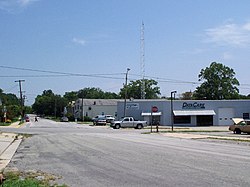Victoria, Virginia
| Victoria, Virginia | |
|---|---|
| Town | |

Street scene in Victoria
|
|
 Location of Victoria, Virginia |
|
| Coordinates: 36°59′36″N 78°13′30″W / 36.99333°N 78.22500°WCoordinates: 36°59′36″N 78°13′30″W / 36.99333°N 78.22500°W | |
| Country | United States |
| State | Virginia |
| County | Lunenburg |
| Government | |
| • Mayor | Carol R. Watson (Since 2000) |
| • Town Manager | Rodney Newton |
| Area | |
| • Total | 2.9 sq mi (7.4 km2) |
| • Land | 2.8 sq mi (7.3 km2) |
| • Water | 0.0 sq mi (0.1 km2) |
| Elevation | 587 ft (179 m) |
| Population (2010) | |
| • Total | 1,725 |
| Time zone | Eastern (EST) (UTC-5) |
| • Summer (DST) | EDT (UTC-4) |
| ZIP code | 23974 |
| Area code(s) | 434 |
| FIPS code | 51-81024 |
| GNIS feature ID | 1496356 |
Victoria is an incorporated town in Lunenburg County, Virginia, United States. The population was 1,725 at the 2010 census, which was down from the 1,821 reported in 2000.
Lunenburg County in the Southside region was established on May 1, 1746 in Great Britain's Virginia Colony from Brunswick County. The county is named for the former Duchy of Brunswick-Lunenburg in Germany, because one of the titles also carried by Britain's Hanoverian kings was Duke of Brunswick-Lunenburg.
After statehood, Virginia grew as part of the original 13 United States. Beginning in 1816, the Virginia Board of Public Works began providing engineering and financial assistance to internal improvements around the state in transportation which continued during most of the 19th century. However, Lunenburg County had been largely passed by as canals, turnpikes, and railroads were built across much of Virginia. At the beginning of the 20th century, the area which was to become Victoria was mostly farmland (primarily cultivating tobacco) and woodlands.
Victoria was founded in 1906 as a planned community on what had been largely undeveloped land during the construction of the Tidewater Railway. This was a new east-west railroad chartered in 1904 with its right of way quietly secured in 1904 and 1905, so as to not alert the competition regarding plans to transport coal originated by its sister Deepwater Railway operating in southern West Virginia. The Tidewater Railway was chartered to cross Virginia from the West Virginia border near Glen Lyn, Virginia in Giles County by way of Roanoke and Suffolk to port at Sewell's Point on Hampton Roads near Norfolk, Virginia. Both railroads were planned and built by the team of mining manager and civil engineer William Nelson Page and industrialist and financier Henry Huttleston Rogers, and added a third Hampton Roads coal exporting railhead to the existing Chesapeake and Ohio Railway (with coal piers at Newport News) and the Norfolk and Western Railway's similar facilities at Norfolk's Lambert's Point.
...
Wikipedia
